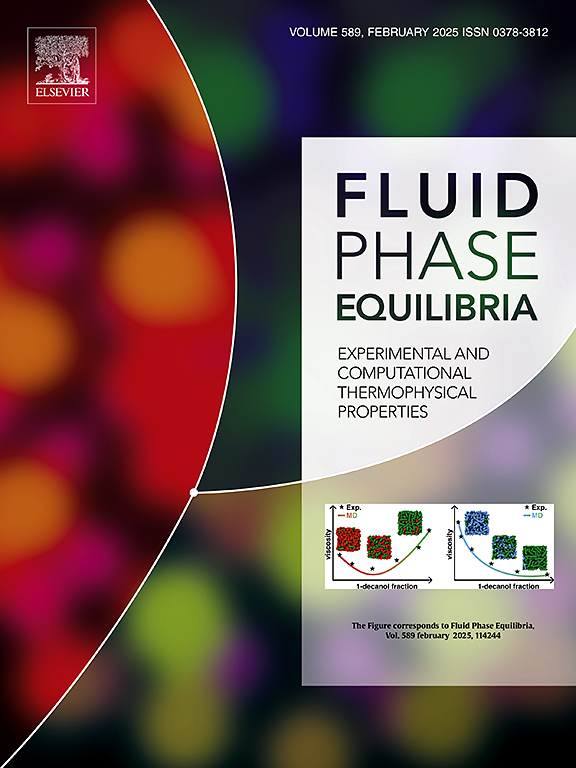Self-solvation energies: Extended open database and GNN-based prediction
IF 2.8
3区 工程技术
Q3 CHEMISTRY, PHYSICAL
引用次数: 0
Abstract
Solvation energies play a crucial role in various chemical processes, ranging from chemical synthesis to separation techniques. To optimize these processes, it is essential to accurately predict solvation energies across different temperatures and solvents. However, most existing studies primarily focus on the standard temperature of 298.15 K. In this work, we address this limitation by creating an extensive database, which combines the DIPPR and Yaws databases. Our comprehensive dataset includes 5420 pure compounds, resulting in 71,656 data points spanning a wide range of temperatures. Additionally, besides the development of this novel database, another key contribution of this work is the coupling of the well-known Graph Convolutional Neural Network Chemprop, with our database with the aim of predicting self-solvation energies across diverse temperatures for the first time. The results presented here demonstrate the overall effectiveness of the model, evidenced by a low Mean Absolute Error (MAE) of 0.09 kcal mol−1 and a high Determination Coefficient (R²) of 0.992. Additionally, the Average Relative Deviation (ARD) of the data is 2.2 %, further confirming the accuracy of the model. In fact, the model demonstrates robust predictive performance across data of varying quality, including a significant fraction of pseudo-experimental values derived from predictive schemes. However, it is worth noting that some groups of compounds, such as small sized compounds and low-numbered ring structures, exhibited somewhat larger deviations than expected. This suggests areas for further refinement and indicates that while the model is robust, there is still room for improvement in specific cases. This approach represents an overall improvement over previous models and offers enhanced versatility for practical applications in chemical synthesis and separation processes.
自溶剂化能:扩展开放数据库和基于gnn的预测
从化学合成到分离技术,溶剂化能在各种化学过程中起着至关重要的作用。为了优化这些过程,必须准确预测不同温度和溶剂下的溶剂化能。然而,大多数现有的研究主要集中在298.15 K的标准温度上。在这项工作中,我们通过创建一个广泛的数据库来解决这一限制,该数据库结合了DIPPR和雅司数据库。我们的综合数据集包括5420种纯化合物,产生71656个数据点,跨越广泛的温度范围。此外,除了这个新数据库的开发之外,这项工作的另一个关键贡献是将著名的图卷积神经网络Chemprop与我们的数据库耦合起来,目的是首次预测不同温度下的自溶剂化能。结果表明,该模型总体上是有效的,平均绝对误差(MAE)为0.09 kcal mol - 1,决定系数(R²)为0.992。此外,数据的平均相对偏差(ARD)为2.2%,进一步证实了模型的准确性。事实上,该模型在不同质量的数据中表现出稳健的预测性能,包括来自预测方案的大量伪实验值。然而,值得注意的是,某些基团的化合物,如小尺寸化合物和低编号的环结构,表现出比预期更大的偏差。这表明了需要进一步改进的领域,并表明虽然模型是健壮的,但在特定情况下仍有改进的空间。这种方法代表了对以前模型的全面改进,并为化学合成和分离过程的实际应用提供了增强的多功能性。
本文章由计算机程序翻译,如有差异,请以英文原文为准。
求助全文
约1分钟内获得全文
求助全文
来源期刊

Fluid Phase Equilibria
工程技术-工程:化工
CiteScore
5.30
自引率
15.40%
发文量
223
审稿时长
53 days
期刊介绍:
Fluid Phase Equilibria publishes high-quality papers dealing with experimental, theoretical, and applied research related to equilibrium and transport properties of fluids, solids, and interfaces. Subjects of interest include physical/phase and chemical equilibria; equilibrium and nonequilibrium thermophysical properties; fundamental thermodynamic relations; and stability. The systems central to the journal include pure substances and mixtures of organic and inorganic materials, including polymers, biochemicals, and surfactants with sufficient characterization of composition and purity for the results to be reproduced. Alloys are of interest only when thermodynamic studies are included, purely material studies will not be considered. In all cases, authors are expected to provide physical or chemical interpretations of the results.
Experimental research can include measurements under all conditions of temperature, pressure, and composition, including critical and supercritical. Measurements are to be associated with systems and conditions of fundamental or applied interest, and may not be only a collection of routine data, such as physical property or solubility measurements at limited pressures and temperatures close to ambient, or surfactant studies focussed strictly on micellisation or micelle structure. Papers reporting common data must be accompanied by new physical insights and/or contemporary or new theory or techniques.
 求助内容:
求助内容: 应助结果提醒方式:
应助结果提醒方式:


